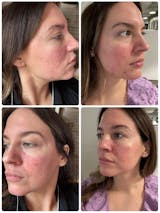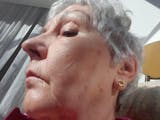There is a lot of misinformation out there regarding how to treat acne so we wanted to debunk and give you honest advice here:
Q: Do I need to see a dermatologist or aesthetician?
A: Over 95% of the people who have acne can treat using non-prescription products without paying big bucks to see a dermatologist or aesthetician.
So why are acne, blackheads, clogged pores and whiteheads so prevalent when the tools to manage them are readily available?
Most people are using the wrong products or are using them improperly.
Also there is too much focus on products that treat a breakout after it has already surfaced when the focus should be on stopping lesions from surfacing in the first place.
Atropic scarring left behind from acne lesions are very difficult to repair later on in life. Scar repair is usually what leads to costly visits to the dermatologist.
Over 80% of the people who sign up for our ClearlyRx subscription platform are first recommended to use our Clear Out lotion instead of signing up since the Clear Out is already sufficient to stop new breakouts without requiring prescription acne medications.
Q: What non-prescription tools do I have to stop acne?
A: Benzyol Peroxide (BP) is your first line treatment for acne. There is a common misconception that BP should only be applied as a spot treatment option AFTER the acne lesion has already surfaced.
However, BP is more effective being applied BEFORE the breakout occurs.
Spread a thin layer of BP across acne prone areas of your face as a preventative measure.
If BP has not worked for you, step up by using retinol+AZA to flush out dead skin cells inside your pores.
The oil on the surface of skin is a complex mixture of sebum, lipids (from the surface skin cells), sweat and dirt. Dead skin mixed with this oil production creates the plugs which clog your pores and the Clear Out will flush out this dead skin so clogs are less likely to form.
The Clear Out hits acne from multiple angles by blending multiple active ingredients that work together and at the same time simplifies your skincare routine. It is gentle enough to be left on overnight where it has enough time to penetrate deep into the pore.
This product packs quite a punch so only apply every alternate night until your skin adjusts to the strength. From there you can step up to nightly application:
Q: Are there different tools needed for different types of acne?
A: There are simple solutions for the types of acne which commonly occur on the face:
Bacterial acne is the most common and can be managed using BP and the Clear Out.
Fungal acne is less common and the most convenient treatment would be to introduce anti-dandruff shampoo into your shower routine alongside the Clear Out.
Leave the shampoo onto affected areas for three minutes so the anti-fungal ingredients in the shampoo will help to abate the itchy, whitehead-looking breakouts.
If you need stronger medication to treat fungal acne or if you have cystic or nodular acne, consider seeing a dermatologist for prescription medication.
If you are not sure what type of acne affects you, feel free to send us a selfie via Facebook Messenger.
Q: What about XYZ product that I am currently using?
A: If the products in your routine are not stopping acne lesions from surfacing, discontinue use.
The rookie mistake is to keep adding ineffective products into your routine in the hopes that they will work in combination to stop breakouts.
Simplify and use a single high quality product that is effective in stopping the breakouts from surfacing.
We get a lot of people who use overpriced cleansers, masks or scrubs which have little or no effect on stopping acne.
This is because cleansers, masks and scrubs are not left on long enough to penetrate deep into the pore to make a difference.
If you have questions about a product, click Send Message from our Facebook page and we can give you guidance.
Q: Should I stop wearing makeup if I have acne?
A: You donate have to stop wearing makeup altogether, but you might try switching brands or going with a different type. If you're noticing breakouts along the sides of your temples, hair creams or gels might be exacerbating your acne.
Look for cosmetics and toiletries with the label acnenon-comedogenicac meaning that they donate clog pores.
Q: Can what I eat cause acne breakouts?
A: The short answer is YES. What you eat can increase or decrease sebum production. However, it is not what you expect. Avoid foods which boost sebum production and therefore trigger more breakouts on acne-prone skin. Learn more here.






